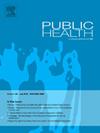墨西哥自我报告的严重视力障碍患病率及其与社会人口特征和慢性病的关系:一项全国性的横断面研究
IF 3.2
3区 医学
Q1 PUBLIC, ENVIRONMENTAL & OCCUPATIONAL HEALTH
引用次数: 0
摘要
目的:严重视力障碍是一个主要的公共卫生问题,它降低了生活质量并带来了巨大的成本。了解其流行情况和相关因素对于有效预防和护理战略至关重要。本研究调查了墨西哥成年人严重视力障碍的患病率及其与社会人口因素和常见慢性疾病的关系。研究设计全国性横断面研究。方法:我们使用了参加2018年墨西哥全国健康与营养调查的43070名20岁及以上成年人的数据,这是一项具有全国代表性的墨西哥人口调查。通过自我报告的华盛顿小组功能短集评估严重视力障碍。考虑到抽样权重和调查的复杂设计,我们计算了患病率和置信区间。我们使用经年龄调整的加权泊松回归模型来估计社会人口学特征与慢性疾病伴严重视力障碍之间的关系。结果经年龄调整的重度视力障碍患病率为2.8%。在低社会经济地位、低教育程度、农村地区以及讲土著语言或失业的人中,患病率较高。患有糖尿病或高血压的参与者也有较高的严重视力障碍患病率。结论这些结果突出了严重视力损害发生率较高的亚组。墨西哥和有墨西哥人口的国家的政策制定者应优先考虑边缘化和弱势群体的有效眼保健。落实联合国大会关于将眼科保健纳入全民健康覆盖的决议,可以惠及受影响最严重的人群。本文章由计算机程序翻译,如有差异,请以英文原文为准。
Prevalence of self-reported severe vision impairment and its association with sociodemographic characteristics and chronic diseases in Mexico: A nationwide cross-sectional study
Objectives
Severe vision impairment is a major public health concern, diminishing quality of life and driving significant costs. Understanding its prevalence and associated factors is essential for effective prevention and care strategies. This study investigates the prevalence of severe vision impairment in Mexican adults and its association with sociodemographic factors and common chronic diseases.
Study design
Nationwide cross-sectional study.
Methods
We used data from 43,070 adults aged 20 years and older who participated in the 2018 National Health and Nutrition Survey, a nationally representative survey of the Mexican population. Severe vision impairment was assessed through the self-reported Washington Group Short Set on Functioning. We calculated prevalence and confidence intervals considering sampling weights and the complex design of the survey. We used weighted Poisson regression models adjusted by age to estimate the association between sociodemographic characteristics and chronic diseases with severe vision impairment.
Results
The age-adjusted prevalence of severe vision impairment was 2.8 %. The prevalence was higher in low socioeconomic status, low educational attainment, rural regions and among those who spoke an indigenous language or were unemployed. Participants living with diabetes or hypertension also had a higher prevalence of severe vision impairment.
Conclusions
These results highlight subgroups with a higher prevalence of severe vision impairment. Policymakers in Mexico and countries with Mexican populations should prioritize effective eye health for marginalized and disadvantaged groups. Implementing the United Nations General Assembly resolution to include eye care in universal health coverage can reach those most affected.
求助全文
通过发布文献求助,成功后即可免费获取论文全文。
去求助
来源期刊

Public Health
医学-公共卫生、环境卫生与职业卫生
CiteScore
7.60
自引率
0.00%
发文量
280
审稿时长
37 days
期刊介绍:
Public Health is an international, multidisciplinary peer-reviewed journal. It publishes original papers, reviews and short reports on all aspects of the science, philosophy, and practice of public health.
 求助内容:
求助内容: 应助结果提醒方式:
应助结果提醒方式:


